“But the most difficult undertaking was the transport of these obelisks by sea to Rome, in ships that aroused the greatest admiration. The late Emperor Augustus blessed the ship that carried the first obelisk to the port of Puteoli as a lasting reminder of this miraculous endeavor; but it was destroyed by fire. As for the ship in which, on the orders of Emperor Caligula, the other obelisk had been transported to Rome, after being preserved for several years and considered the most miraculous construction ever seen on the seas, was brought to Ostia: by order of the late Emperor Claudius; and towers of Puteolan earth1 were first built on it and was sunken for the construction of the harbour that he was making thereon." - Plinius, Natural History, 36.14
This is how Pliny described the overseas transport of obelisks and how special the ships made for this were. Of course, this applies not only to obelisks, but also to other large and / or heavy items. Particularly for the many marble from Carrara and other locations that was used in such abundance within the empire, but especially in Rome. This article is about the problem of this transport, which is mainly based on a study by Patrizio Pensabene2.

In the empire there was a large port network to import and distribute marble to Rome. The data on which we can reconstruct this network has to come from the finds of rough blocks: the places where the largest concentration of raw marble was found were located in and around Rome, the Fiumicino canal (fossa Traiana), the seaport of Portus, the river / seaport of Ostia, some unloading points along the Tiber and the docks of the river port of the Emporium4 of Rome with the western and northern Campus Martius (Field of Mars). These concentrations reflect the reality of an integrated port system, using the Tiber, navigable canals and an extensive road communication network between the different port areas.
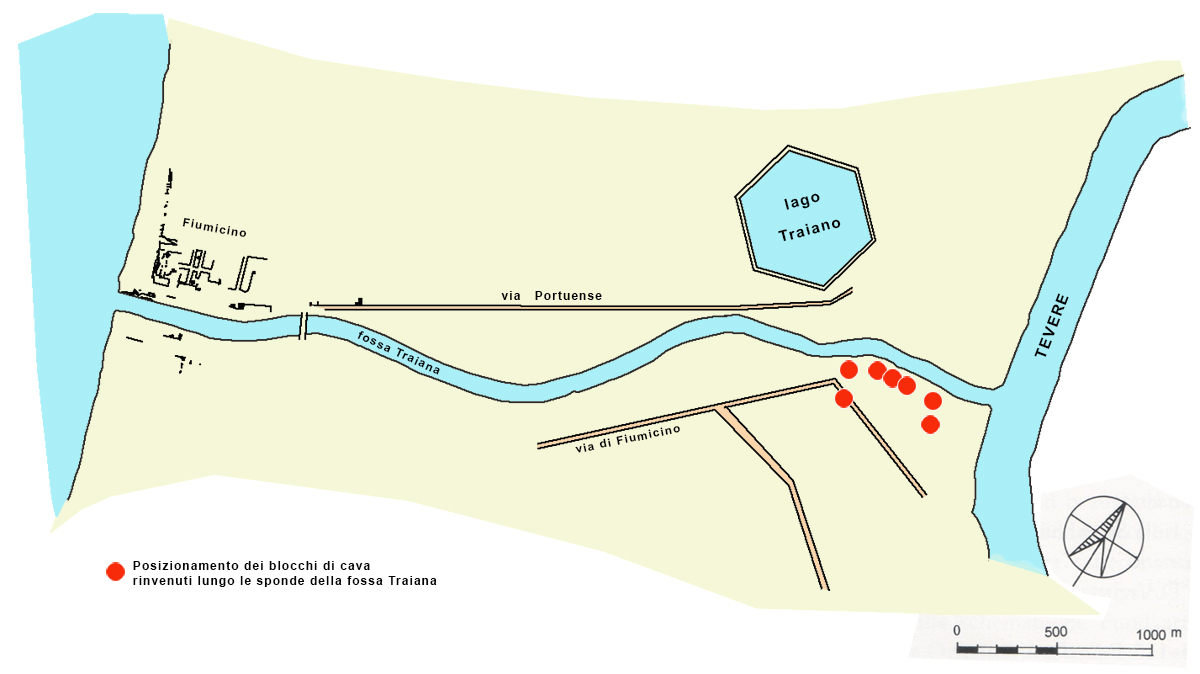
In Portus most of the most common blocks have been found just before the Capo Due Rami, where the canal flows into the Tiber. Three to four hundred blocks were found here in the nineteenth and twentieth century. Many of these blocks have been dredged from the bottom of the canal, but also, to a lesser extent, have been found on the banks. These finds were accompanied by numerous fragments and chips from machining and of semi-finished products from which we can conclude that the first modelling of the supplied raw marble took place in the warehouses along the canal.
First of all, the marble found gives us some assurance that ships carrying loads of blocks and columns of small and medium size took their cargoes to Portus and unloaded them there on the banks of the canal instead of continuing straight on to Rome.
At a later point in time, at the request of the statio marmorum6 office in Rome, the cargo was placed back on boats and transported against the current of the Tiber towards Rome. Not always on the same ships. Only after the opening of the fossa Traiana, which allowed loads of 350 tons to be transported, one did no longer have to sail up the mouth of the Tiber because it was highly susceptible to salinization.
Before that period, large objects were transferred to smaller ships that took them further to Rome.
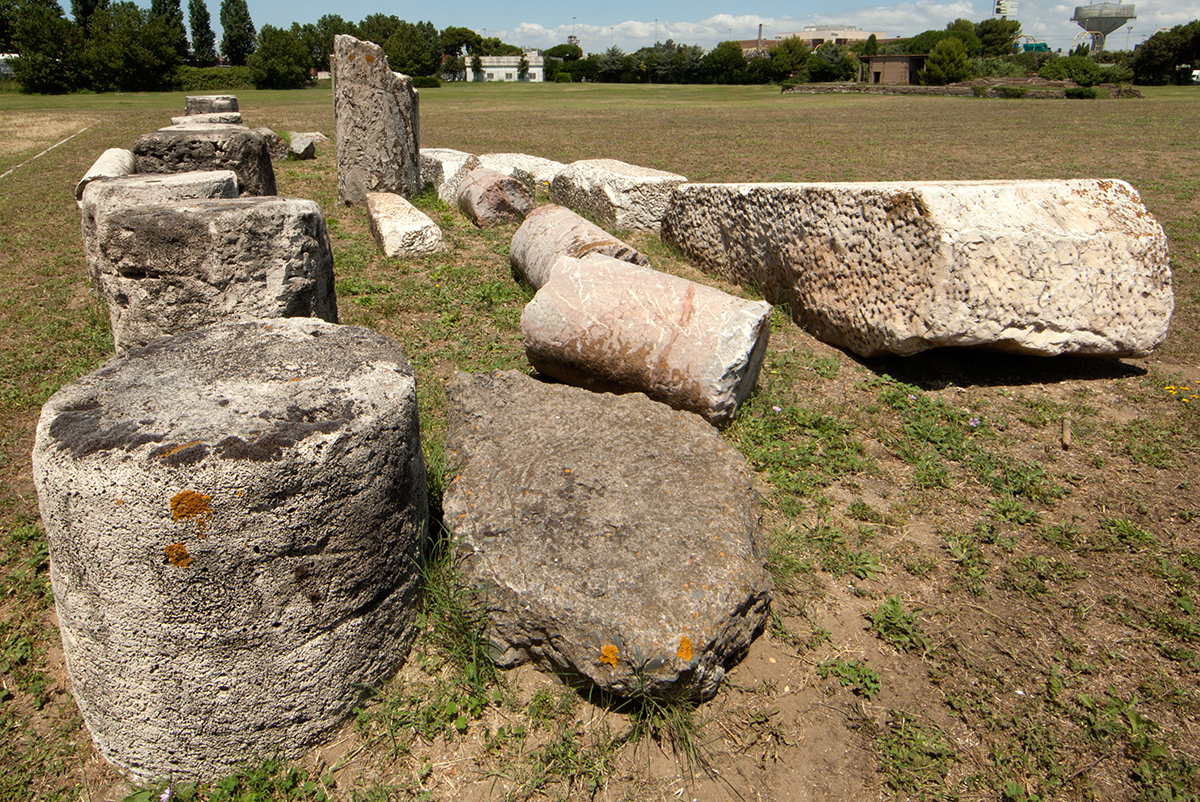
From the opening of the aforementioned canal, it was thus possible to distinguish between the normal small and medium cargo blocks and those of exceptionally large size such as obelisks and monoliths of 9, 12 or 16 meters, which were transported individually or in pairs on specially prepared ships. For this latter transport the usual naves caudicariae7, with which sacks of grain and oil or wine amphorae were transported could not be used, because these ships had highly upright sides.
We know from Pliny that the ship with the obelisk for the Circus Maximus, built by Augustus in 30 BC, was first brought to Rome, later to Portus where it was filled with cement and sunk to serve as the foundation for the lighthouse in the port of Claudius8.
Earlier, obelisks were transported to Rome on smaller boats. Obelisks such as the one named by Pliny weight 300 tons or more, and the ship that brought the obelisk to Ostia could hardly navigate the mouth of the Tiber to transport it to Rome. But at the time of Claudius and Nero, after the opening of the fossa Claudia (later Traiana), the large monoliths could ignore the mouth of the Tiber, as we can see in the transport of the obelisk that the Emperor Constantine II brought from Alexandria to Rome in 357 after Chr.9
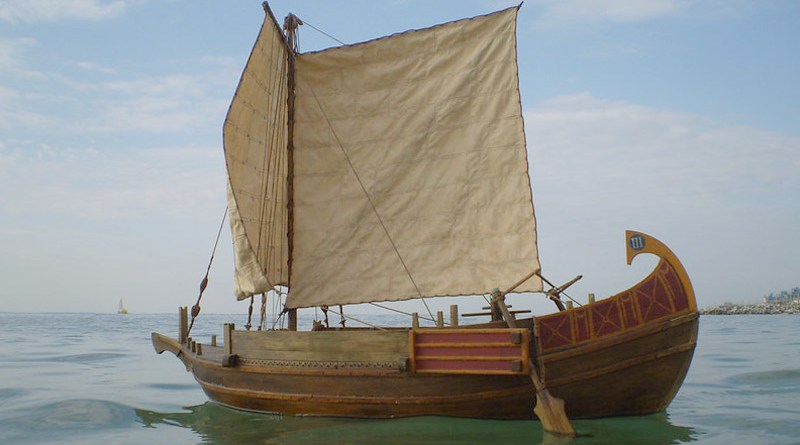
In the port of Claudius, two caudicariae about 20 meters long with a tonnage of about 50 tons have been found and are now kept in the ship museum in Fiumicino. These ships were equipped with a towing, folding boom with a pulley system to which a trapezoidal sail could be rigged also. The flat barges used for the large columns must have been the same, but without uprights and a keel adapted to the depth of the Tiber.
The Emporium, the river harbour in Rome
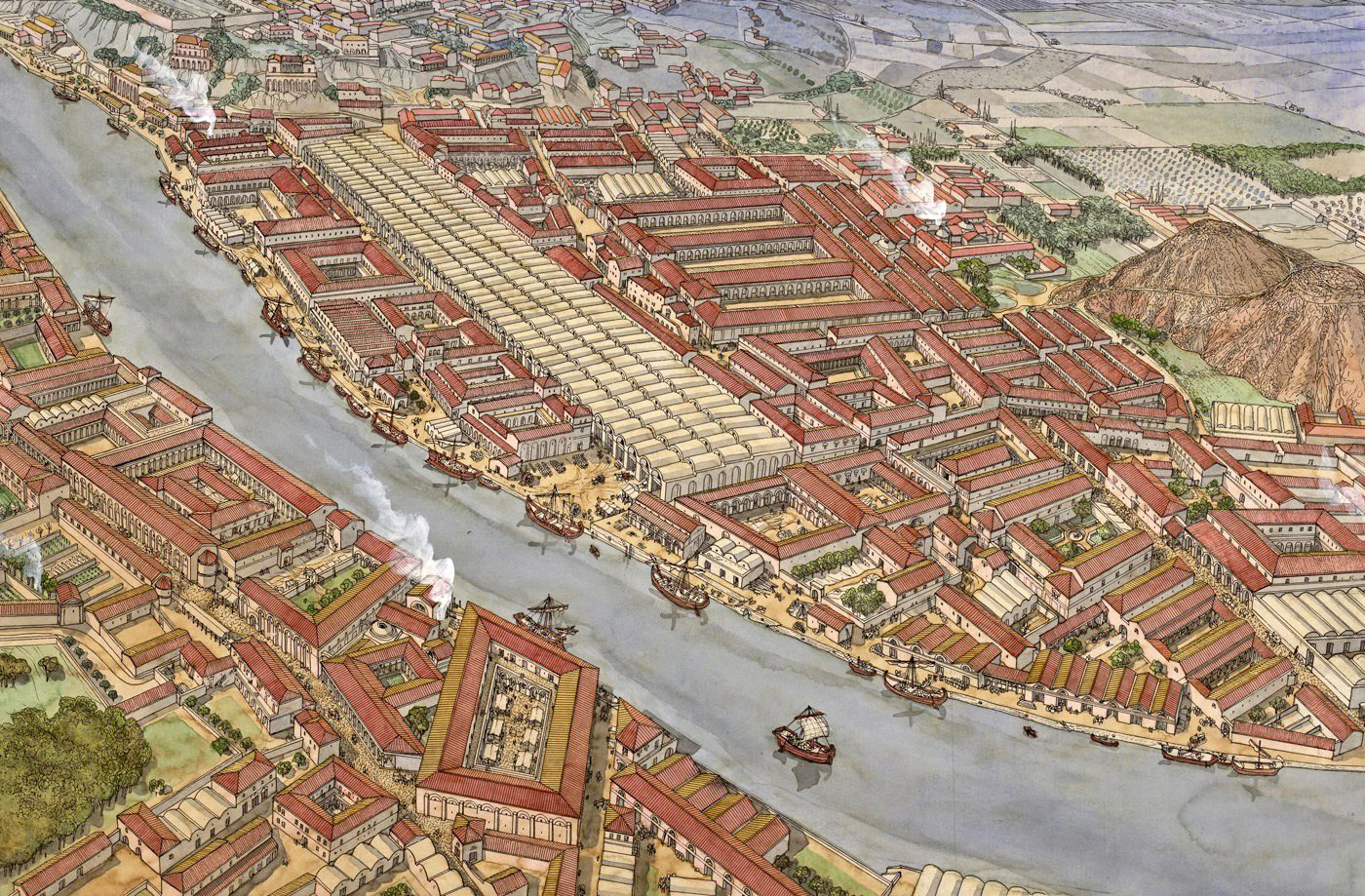
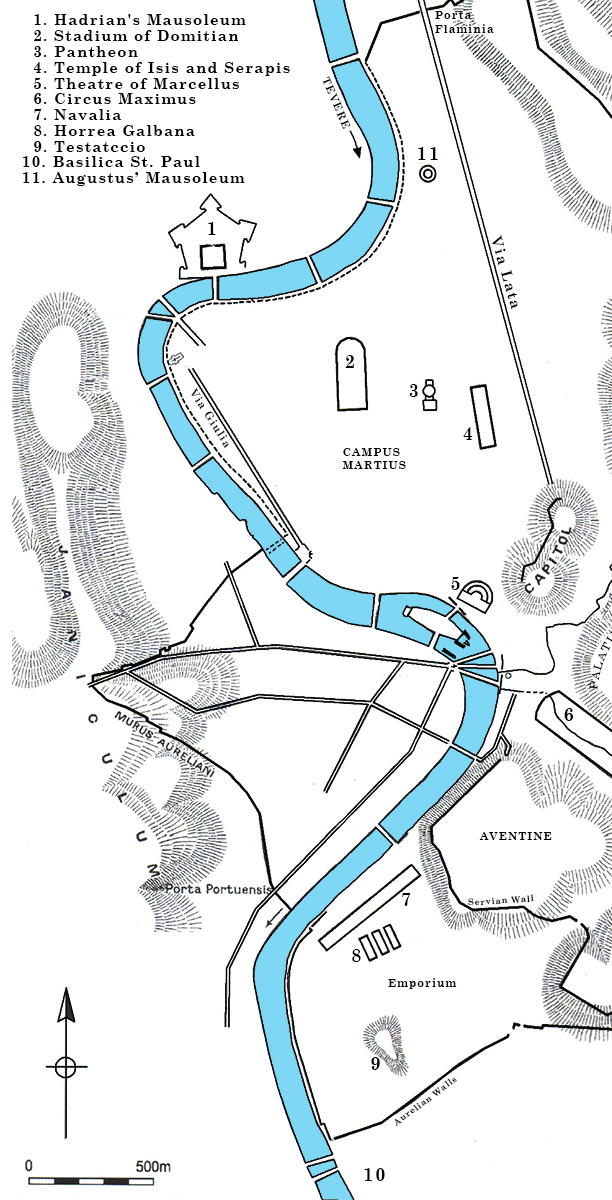
The river port of Emporium11 stretched from the plain of the Aventine till Monte Testaccio12 where as many as 1,400 large pieces and thousands of smaller fragments and splinters of marble were found during the excavations of Visconti13 between 1868 and 1870.
Excavations from the 1980s too confirmed the many marble depots in the district along the Tiber, southwest of the porticus Aemilia14. Inscriptions have also been found nearby concerning the traders involved in the marble trade.
In order not to 'drown' in marble the large depots at the foot of the Aventine, where also the Statio Marmorum was located, there was a need for smaller warehouses at other places along the bank of the Tiber between Ostia and Rome (especially in the area north of the basilica of Saint Paul outside the walls) including the right bank of the Tiber just before the Porta Portese where countless blocks of marble from quarries have been found. The same goes for the place where the Esquilino reaches the Tiber. Here too, warehouses and traces of sculpture workshops have been found.
While these small stores do not provide much more additional archaeological evidence, they are important for allowing us to reconstruct the amount of activities that took place in the transport of marble across the Tiber. The few inscriptions on the blocks that we have available point to a time no older than the late first century AD. as shown by the reused blocks in St. Paul's Basilica. According to an unpublished manuscript by G. Gatti15 small depots have been found at regular intervals along the left bank of the Tiber, past the Basilica of St. Paul.
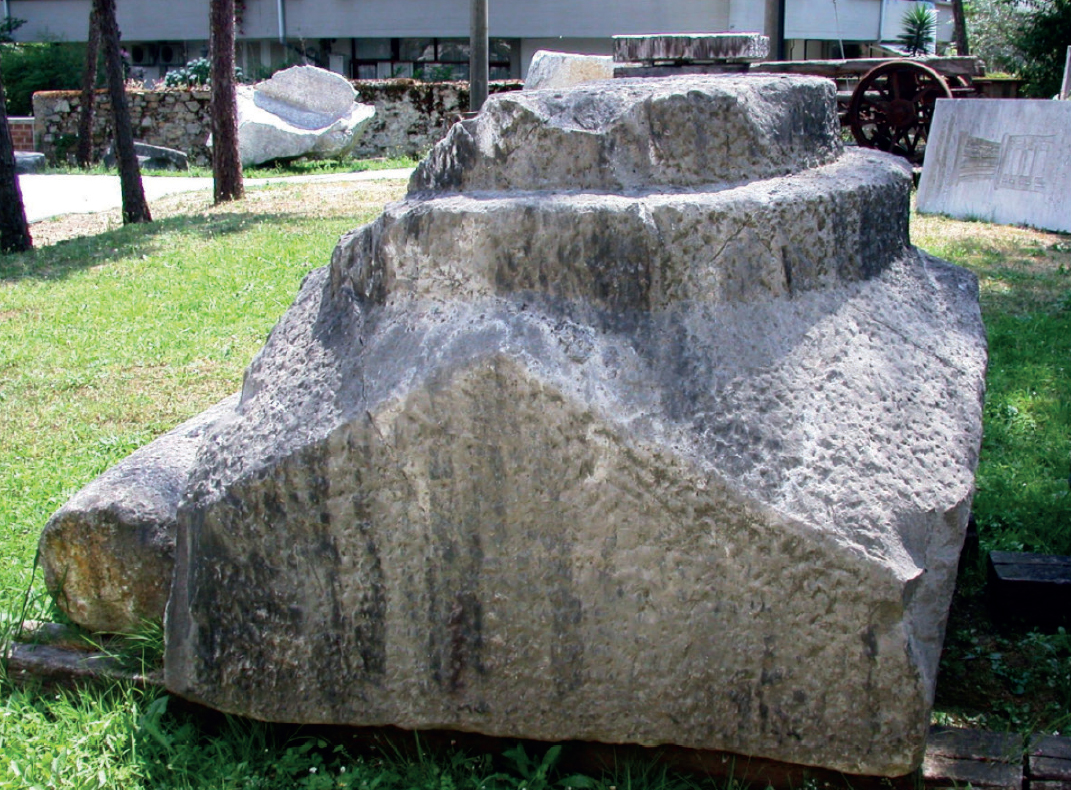
Figure 7: Preprocessed marble block from Luna
Best documented are the finds at the Gazometro (gas tank) between the Via Ostiense and the Tiber16 still on the left bank, and halfway between the Aurelian walls and San Paolo. Here 26 preprocessed pieces of marble have been recovered, raw as well as semi-finished, but also processing waste: 15 of the 26 are real blocks, the others are parts of African cipolin, gray and alabaster columns, many with signs of reuse or with holes for plugs: some also had still the metal clamps to repair fractures.
The small depots must be taken seriously because the functioning of the large marble warehouses between the seaport of Portus and the river port of Emporium depended on them. If indeed the larger warehouses could no longer cope with the abundance of blocks from the quarries, it was necessary to organize other landing and storage sites for proper storage.
But there is one more possibility that does not exclude the others: some of the small depots are said to have been managed by negotiatores marmorarii (marble merchants) who were able, for commercial purposes, to buy up in Portus quantities of precious marble that may have been discarded for public architecture. An indication of this could be the fact that in the before mentioned small warehouse on the banks of the Tiber near the Gazometro, shafts of columns with holes for pegs and stubs intended to cut circles in colored marble have been found, but also parts which were apparently rejected due to defects and cracks in the stone.
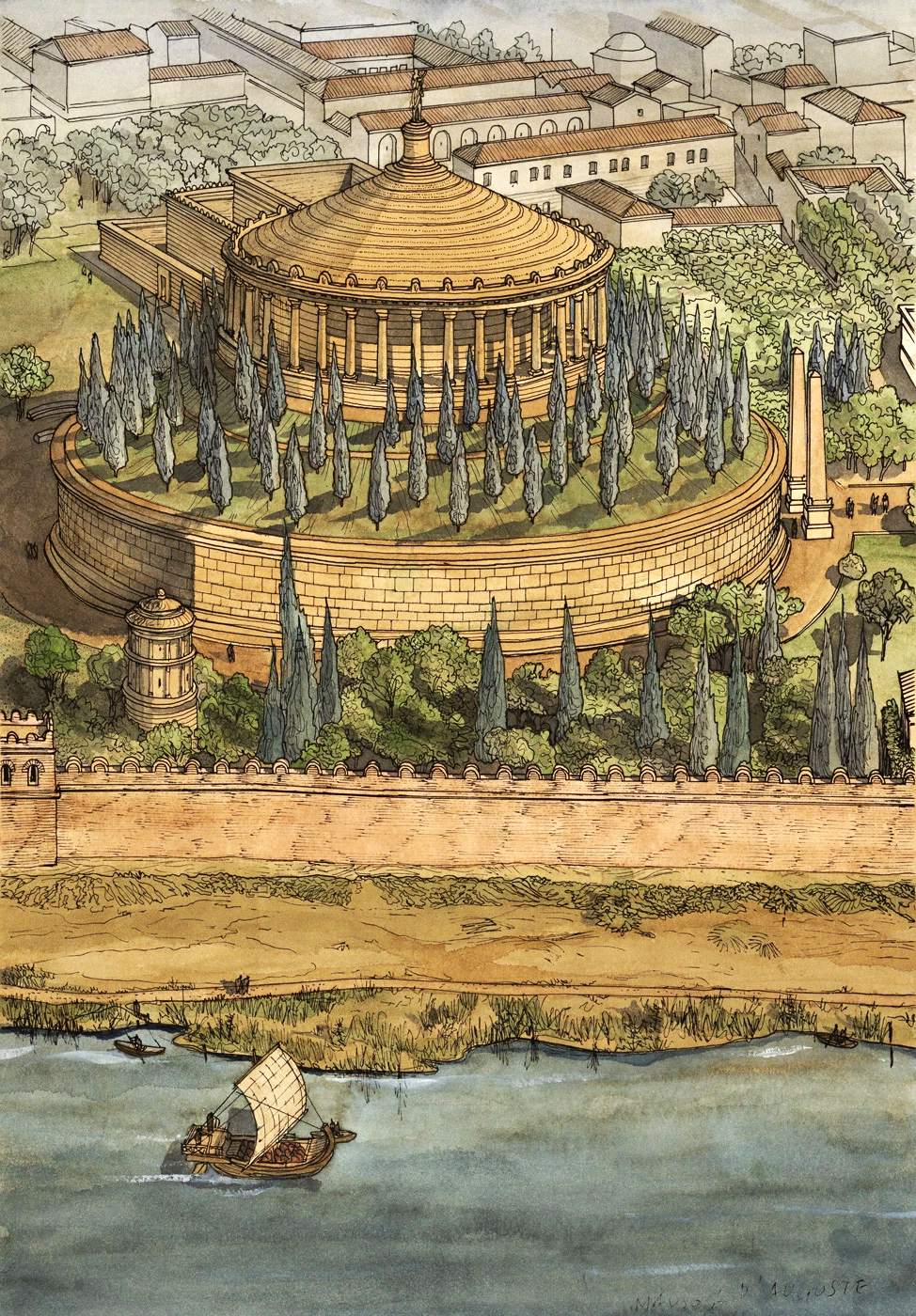
The third point with the largest concentration of marble artifacts from the quarries are the western and northern part of the Field of Mars, which should be regarded as a discharge port for the marble. Not surprising in itself, because many monumental buildings were built in that city quarter from the imperial period, including the first stone theater of Rome (where Julius Caesar was murdered), the Pantheon, the Ara Pacis (peace altar of Augustus) and the stadium of Domitian (the current Piazza Navona). In the 16th century alone, more than 270 raw pieces of marble have been documented, including column drums, blocks and raw sculptures. The various parts often date from the time of Domitian17.
The sites were located in the north up to the banks of the Tiber and some sites in the east (via di Campo Marzio) and north at the Mausoleum of Augustus. Today, the western and northern Mars Field can no longer be imagined as one single and uninterrupted neighborhood of workshops, but it must have looked quite different in ancient times.
The fact that many of the finds have been identified in the immediate vicinity of the Tiber proves that the river also served as the main transport route for the marble used for buildings on the Field of Mars and surrounding area.
In addition to Tor di Nona – where in 1890, on the bank of the Tiber, a pier specially intended for the unloading of marble was discovered – the cargoes of marble also had to be unloaded further north, at that part where the Tiber was closest to Augustus' mausoleum and the via Lata on which the most extensive transports of colossal parts could reach the area of the imperial forums.
The existence of docks for the unloading of marble outside the Tiber Island shows that, despite the number of bridges that had to be passed with modified boats, the river route was clearly favored rather than a demanding transport through the city streets, which was inevitable for places not so close to the river.
Depots have been reconstructed on the Field of Mars that were not at the construction site, but at some distance from the monuments for which the marble was intended.

As a result, the workshops dealing with the processing of blocks, operating in close relationship with the project architects, were not found directly on the construction site itself, but at some distance: such was the case with the statues of the Dacians discovered in the via del Governo Vecchio now belonging to the Torlonia Collection.
Even the marble workshop recently identified near the mausoleum of Augustus operating for the Pantheon, 800 meters away18, was at a long distance from the actual construction site. We won't be far from the truth if we think that this choice depended on the transport route and the space available on the construction site. In any case, the mooring quays along the banks of the Tiber had to have winches and cranes of considerable size and streets suitable for the transport of these large marble blocks.
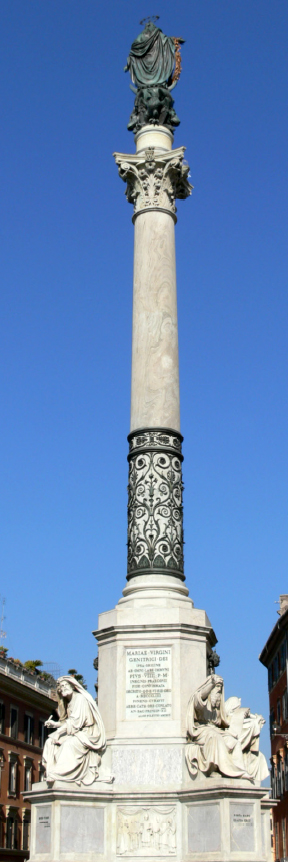
Mignanelli.
The depots of the field of Mars must therefore be judged differently from those of the Emporium in the period of Domitian. The many finds justify the hypothesis of open-air marble warehouses that could make use of the existing Tiber harbour at Tor di Nona. Studies on the history of the nineteenth century19 showed that this part of the city had a unique and extensive tradition of stonemasons and sculptors.
Lanciani20 and others located the headquarters of the statio Marmorum under the church of Saint Apollinare near Piazza Navona.
The warehouses connected to the unloading site at Tor di Nona were not intended to relieve those in the Emporium, but to provide storage for the monuments from the specific areas. The public administration thus opted to send loads directly to those places along the banks of the Tiber that were closest to the locations for which they were intended and where there was a berth connected to roads for transport to the construction site.
Particularly for obelisks and high columnar shafts, it became quite complicated when excessive curves had to be taken, in such a case it was necessary to find berths with roads that could reach the construction site without many curves. Therefore, the finds on the field of Mars showed several large shafts such as those in the Via Zanardelli or the semi-finished products with consular date of Domitian in the initials of the quarry that were thus not yet incorporated or the almost 12 m high column of Cipollino, in 1777 found in the foundations of the monastery of Santa Maria della Concezione on the field of Mars, which was, due to a defect, never used in the intended monument (probably the temple of Matidia21) but later incorporated into the column of the Immaculate Conception at the Piazza Mignanelli; and other columns between 9 and 12 meters of portasanta and granite marble from Africa destined for the Forum and found under the Collegio Clementino. In contrast, the parts of gigantic columnar cores with an original height of 50 or 100 feet found in the area around the unloading site at or just past the Mausoleum of Augustus were also unloaded there because they could be easily transported from there to the Via Lata and from there also reach the imperial forums.
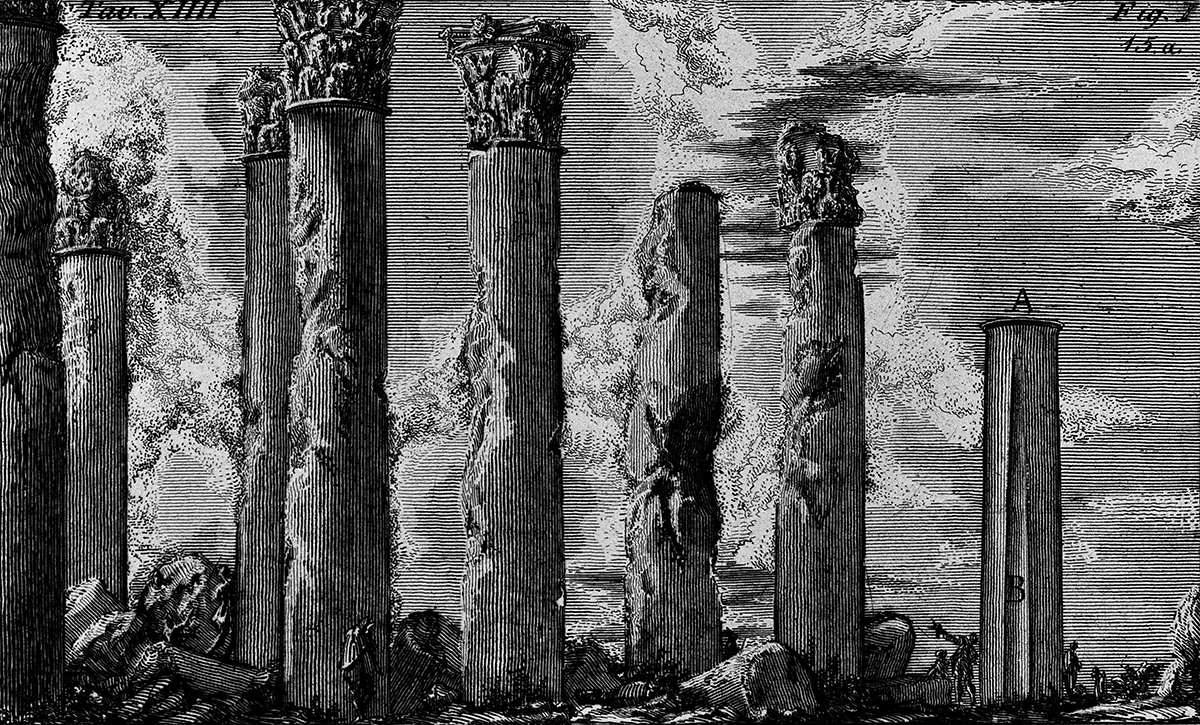
in the 18e century.
On the other hand, there was of course the Tiber harbour itself at the foot of the Aventijn with the unloading facility on the left bank that continued for at least 1.5 km to the Emporium and the parallel extension on the right bank also played a role in this22. Rough marble did not need roofed warehouses for preservation, as was the case with perishable goods to be protected from the elements: the marble from the quarries was therefore left outside, but wherever a depot was established along the banks of the Tiber, unloading machines and transport ships were needed for sure.
The same open-air system applied to Portus, where, as already mentioned, along the southern bank of the fossa Traiana, for the confluence with the Tiber at Capo due Rami, the main stores (not only for marble) were built, although we don’t have remains such as holes for the posts or winches that allow us to reconstruct these facilities.
Also for the location of the port office of the statio Marmorum in Portus that managed the depots and shipments to Rome, there is no indication whether this office was located in the warehouses, in another part of Portus, in the capitaneria (the office of the harbour master) or in a sector of the "imperial palace". What is certain is that the warehouses in Portus also had to be directly connected to easily accessible roads and when the port of Claudius was built, a connection had already been established on the right side of the Tiber that ran to Rome, as we know from the reports of the recovered parts of the pavement. This is undoubtedly the Via Portuensis, built by the Emperor Claudius, which was used until the sixteenth century, although explicit evidence for this name dates from a late period.
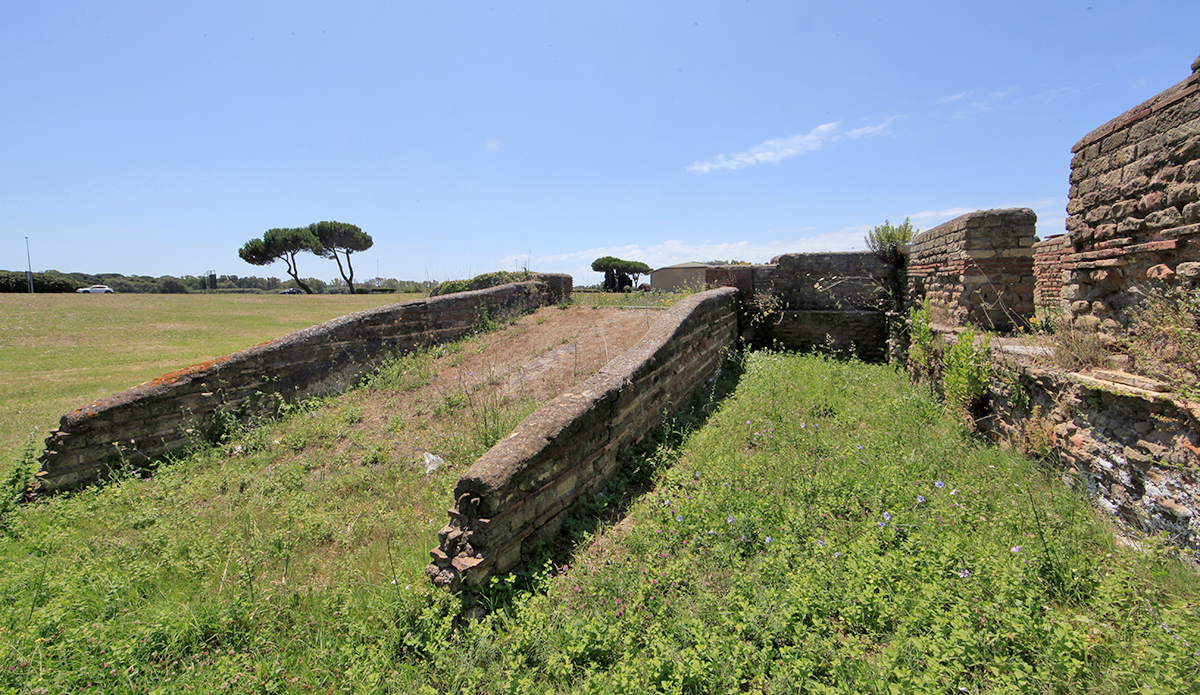
The via Portuensis did not coincide with the so-called towpaths needed to drag the fully loaded ships by animals, against the current of the river, to Rome. For this transport, as for other goods, there were places along the banks of the Tiber for mooring, for the care of draft animals and for housing and food for the staff. The small boats were towed on the Tiber by animals or crew or sailed, in times of crisis, alone with sails and oars23.
To the south of the city limits of Rome, large stretches of river dyke with resting places have been found on both banks of the Tiber. The first stop after Portus was at Ponte Galeria (XII miles from Via Portuensis) where several quarry blocks were found in the river bed. Other moorings along the Tiber were near present-day Magliana, where in ancient times the sanctuary of the goddess Dia with her sacred grove was located24, in Pian Due Torri at the beginning of via Magliana25, in Santa Passera, in San Paolo and Pietra Papa, up to the modern river port under the Ponte di San Paolo26. It should be noted that this part of the Tiber is about one third of the distance Portus-Rome.
The structures at Pietra Papa and at Santa Passera were examined with some attention. Especially in Pietra Papa, not only the remains of bathing establishments, clearly reserved for workers on the Tiber, were examined, but also systems and construction details very similar to the already known facilities of the Emporium in Rome and elsewhere and dating back to the time of Claudius (thus contemporary of his new harbour), such as the concrete walls of opus mixtum27, large quays and the bollards of travertine blocks with holes for capturing the ships and the imperial demarcation stones that bound the berth.

Another port structure is known only from literary sources. Ammiano Marcellino28 informs us that the 450 or 522 ton Theban obelisk, intended for the Circus Maximus was brought by Costantine II in 357 AD. with 300 oarsmen onto the Tiber up to the vicus Alexandri, 3 miles before Rome, where it had been unloaded and probably transported into the city on sledges. Vicus Alexandri is not mentioned by other surviving sources, but is nevertheless easy to find on the basis of Ammiano's data: the third milestone of the Via Ostiense, which stands at a place where the Tiber makes a fairly pronounced curve in a south-westerly direction29. Here the via Ostiense runs right next to the river, but specific archaeological traces of a mooring place have not been reported so far: however, an indication for the connection with an unloading site on that spot can be seen in the two burial columns of employees responsible for the marble from Luna30 found between VII and VIII miles of the Via Ostiense.
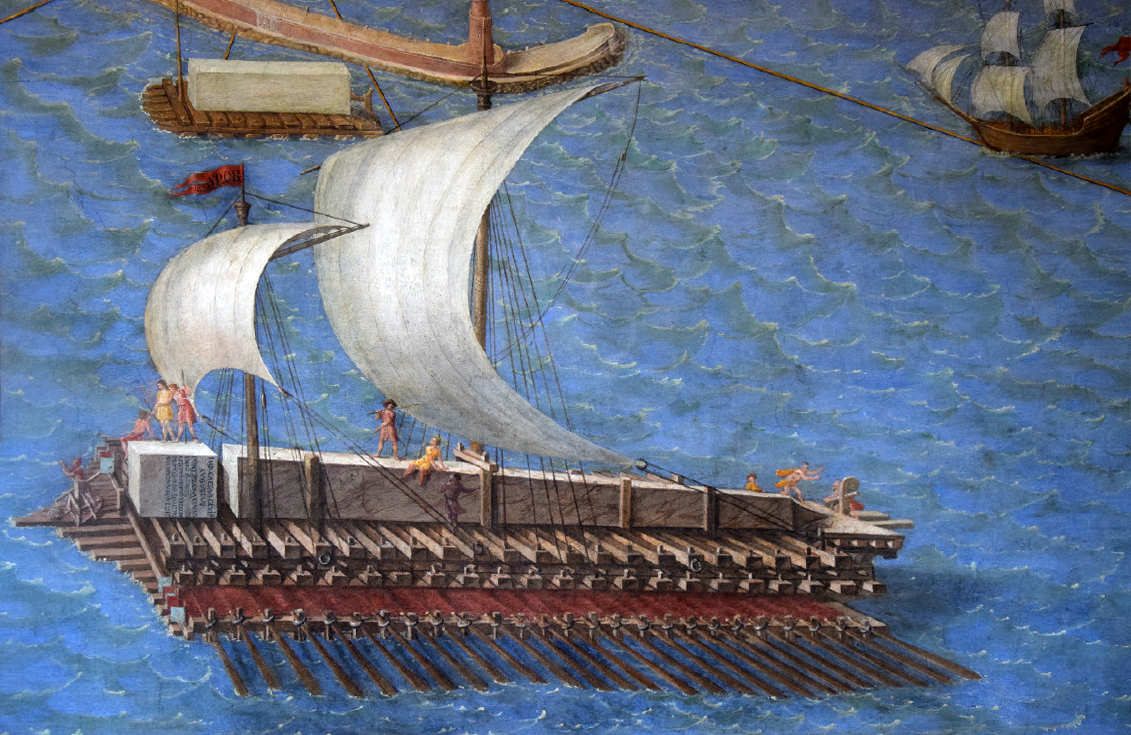
Ammiano's report may have been misinterpreted as evidence of the possibility that even large ships could sail up the Tiber, but his intention was only meant as an indication of the special shapes of the boats that carried them from Alexandria and pulled them across the Tiber.
It should be added that the colossal monolithic pillar shafts of Egyptian granite were usually transported one by one so that they did not have to be transhipped in Portus and could be towed directly further up the canal and the Tiber, with the help of buffalo.
Navigation on the Tiber outside the city was not hindered by bridges, as there were no bridges between the wooden Matidia bridge in Trajan's Canal with its movable part to allow navigation, and the Sublicio bridge in Rome near the Tiber Island: this explains why the river could be navigated by ships of up to 150-200 tons, which could use sails in some sections depending on the current and wind.
The duration of the navigation from Portus to Rome was approximately two to four days, assuming a working day of 12 hours. The whole operation was of such importance to the realization of the building program promoted by the emperor that, in the absence of other sources, the old interpretation is preferred that the corpus traiectus marmorarium was the guild of those responsible for the marble transport across the Tiber to Rome and not a guild responsible for a ferry connection of the banks of the fossa Traiana between the Isola Sacra and Portus as Meiggs suggests32. Given the heavy blocks and especially columns, the transport involved great technical challenges in order to be able to bring it to Rome with certain regularity, it does not seem superfluous to set up a special guild for the executors of such transports.
Once unloaded at one of the berths in Rome, the marble was loaded onto wagons and driven over land to the various destinations or the ship was towed further by the helciarii (persons pulling a ship) via the Tiber, because this was no longer possible with draft animals.
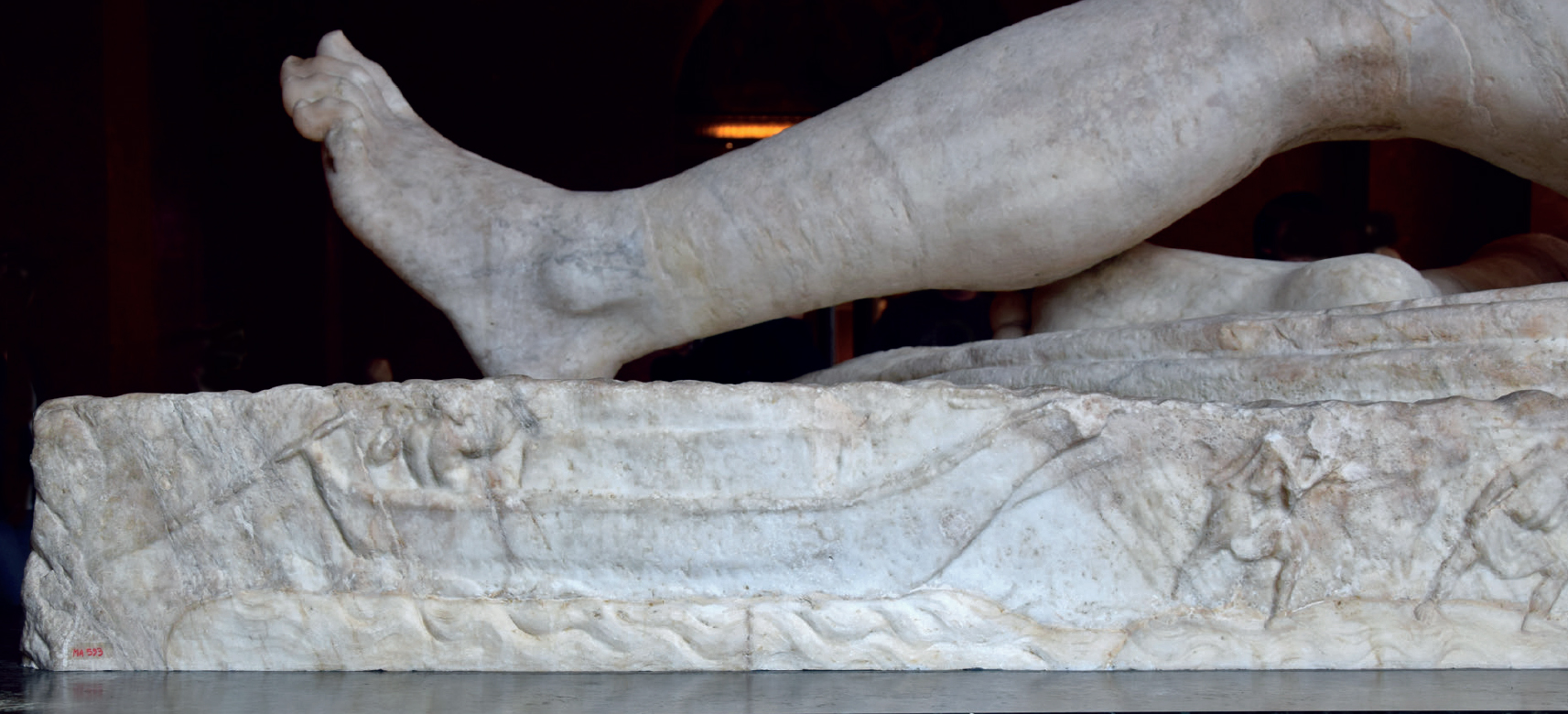
Some bas-reliefs depict transport scenes such as the one at the base of the Tiber statue in the Louvre, in which a heavily loaded boat with a block of marble (?) and a helmsman is being towed by three men using ropes attached to a short mast at the bow of the ship. These types of shallow and elongated boats have been identified with lintres, the boats that sailed on the Roman rivers, and the related skippers with lintrarii. These kind of ships would have been used by the corpus traiectus marmorarium, although it was also quite possible to use the caudicaria for this purpose. In that case on the ship a number of planks was mounted, to create a real raft.
It seems to be an established fact that from Domitian, when an intensive construction activity takes place in Rome, the expansion of harbour depots and especially those where marble was pre-worked begins. What started at the time of Nero expanded during the second century and the Severian era; transporting the marble became a growing problem. That is why the marble often underwent initial processing to ease transport to the construction sites where the actual finishing took place. But also to make land transport less difficult. Hence the prefabrication of architectural elements in the depots of Portus and also in those of Rome.
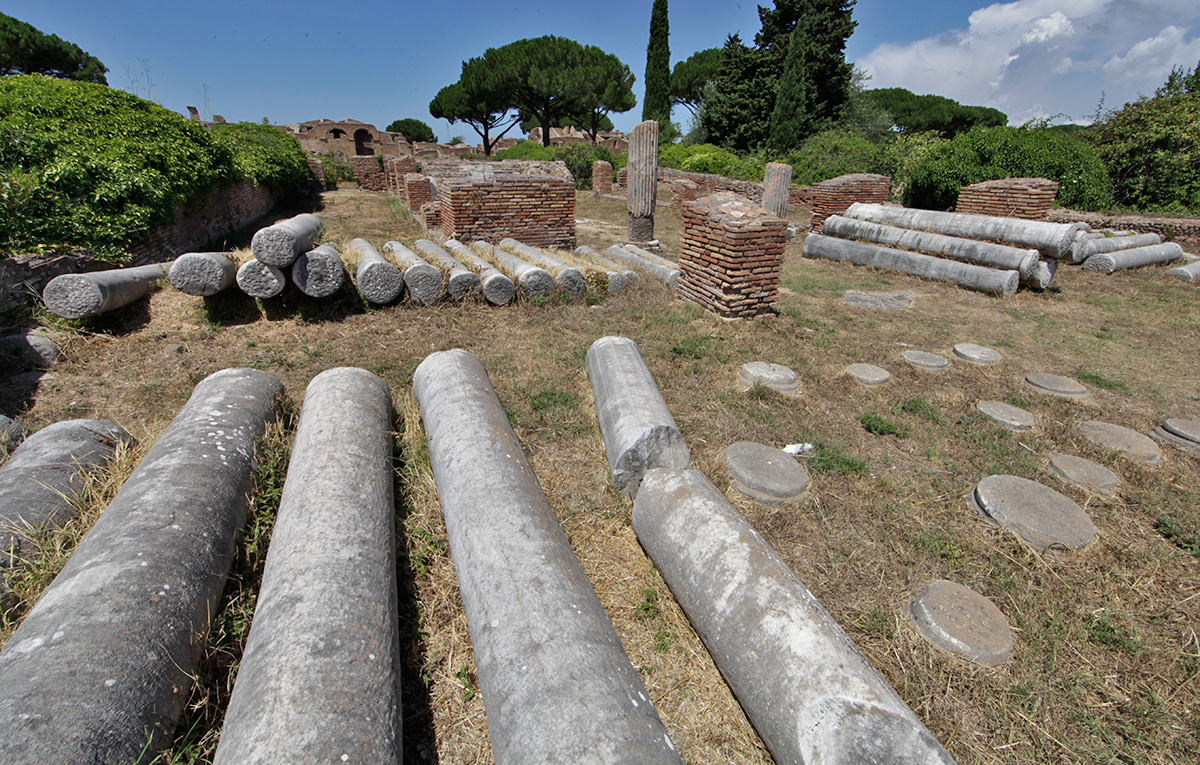
We have seen that in Portus on the banks of the canal of Trajan, at least since Domitian, there were open-air depots for rough blocks and column shafts, which must have been there since the construction of the port of Claudius with a great expansion after Trajan. But where were the blocks transported and unloaded before that time? Ships were normally unloaded on the docks of the Tiber opposite Ostia, where a long quay forming part of these structures was recently found, or they continued straight to Rome and, if so, where was the Tiber landing port in Rome?
We know that dozens if not hundreds of column shafts were imported to Rome as early as the late Republican period (judging by the information we have from the sources on the Scauro theater33). The theme of how to reach the city already played a major role at that time. It is certain that Caesar had imposed a tax, the columnarium34, on the columns that arrived Rome, mainly on private order. Perhaps precisely to cover the costs of the given port infrastructure. It is strange to consider that in the late Republic and the time of Augustus the marble would not go directly to the port in the mouth of the Tiber, so to Ostia, but possibly to Pozzuoli, Terracina or the ports north of Rome such as Civitavecchia and Santa Severa in the case of Carrara marble blocks. In these cases the cargoes would have to be transported further along the coasts to Ostia by a small coaster, and not by land, as the cost of the transport would have been excessive.
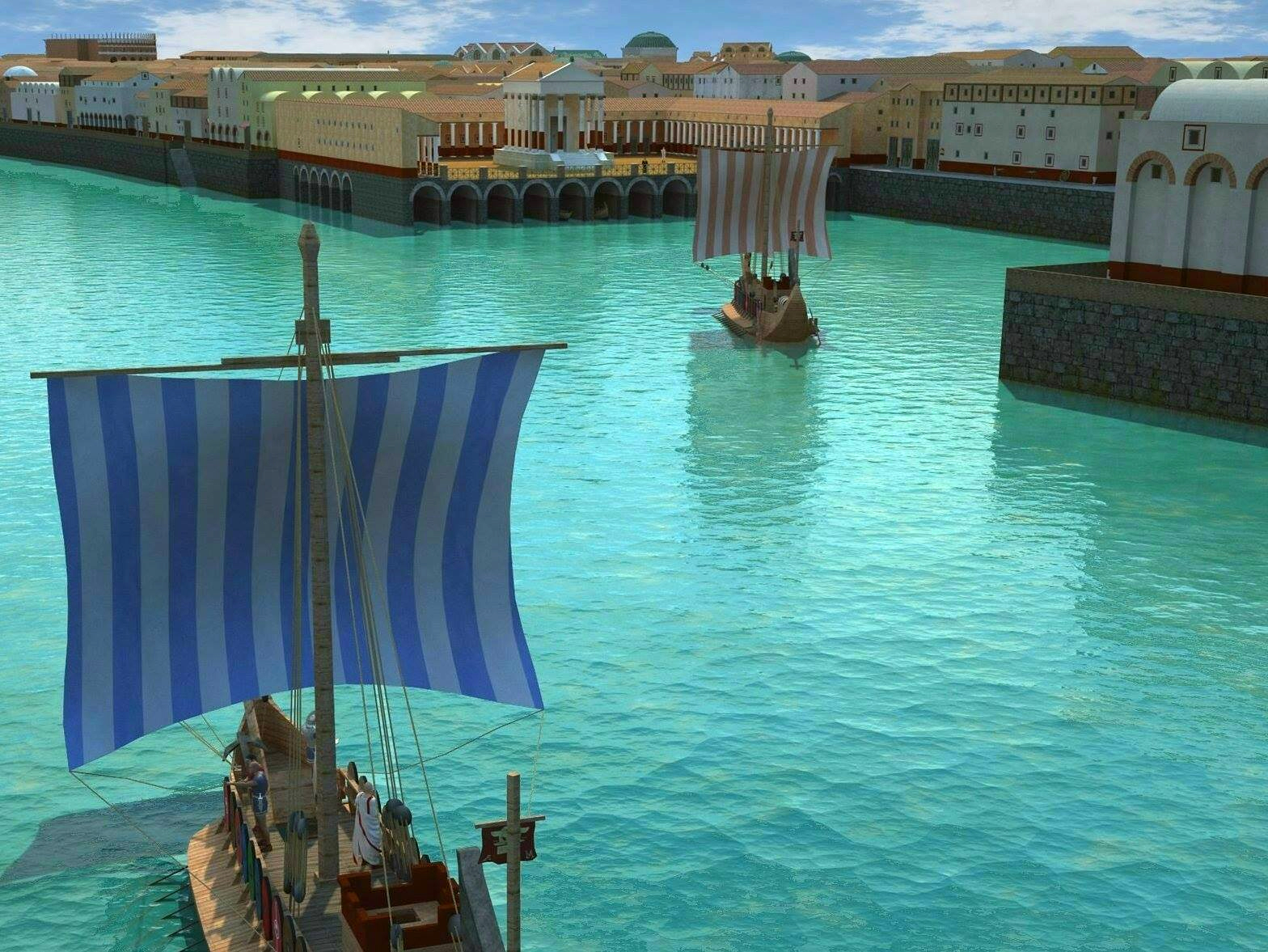
There is currently more information about Trastevere ostiense (area on the north side of the Tiber opposite Ostia) and it seems more likely that the marble was stored there as this bank offered more opportunities to create extensive open-air storage for blocks and columns than the quays of the small harbour basin of about two hectares, on which also a temple and buildings, identified as navalia, stood between the Imperial Palace and the Porta Marina35.
In this case too, there is not sufficient evidence for the reconstruction of port facilities for the unloading of marble from the ships that carried them to Ostia and for loading onto boats for onward transport to Rome.
Before the construction of the port of Claudius, if the weather conditions did not allow to bring the goods to the port of Ostia or later, when the port of Portus became too occupied, the old republican port of Pozzuoli was used again (Pozzuoli was made a colony in 199 BC and had gained importance at the end of the 2nd Punic War). From there the goods, which had been transferred from the naves caudicariae to small coasters, were transported further to Ostia and Portus.
In the monuments of Pozzuoli we also find an abundance of marble from Luni and other colored marble from the time of Augustus, such as the Capitol temple on the acropolis37 and especially the gigantic columns in cipollino and granite of the Macellum from the time of Antoninus suggest a major role of the port of Pozzuoli as a landing place for the large loads of marble. However, no blocks with imperial quarry codes have been found in the city so far.
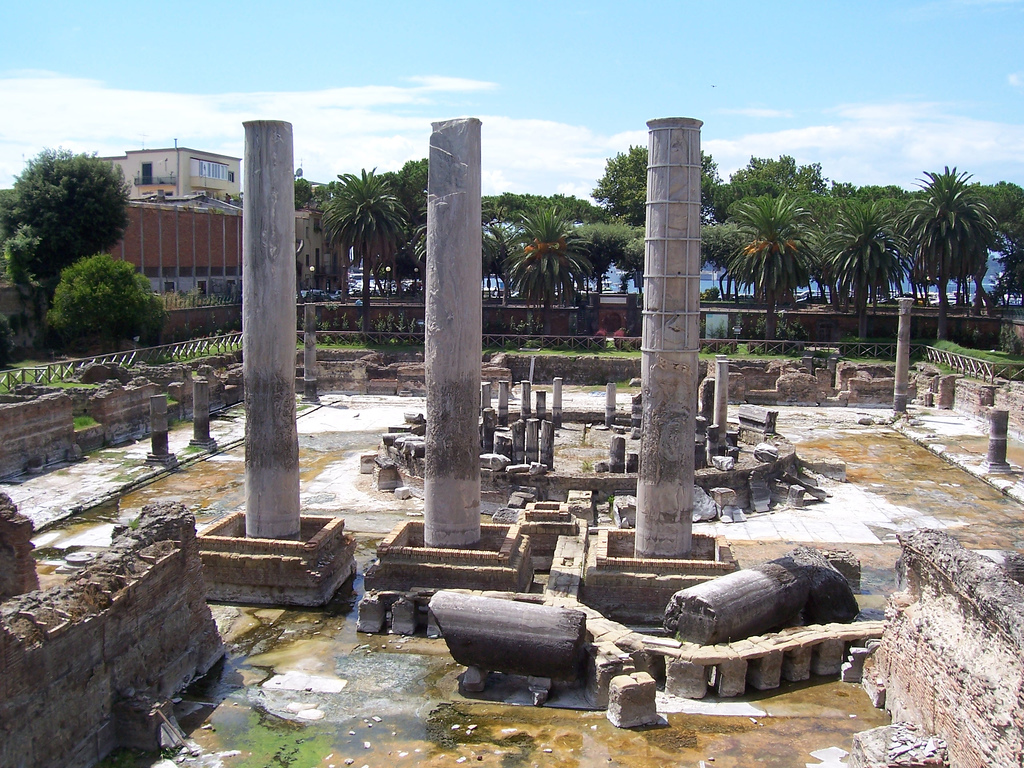
Of course we still have the quote from Pliny opening this article from which we learn that the ship with the obelisk, which Augustus had brought for the Circus Maximus, was placed in a permanent dock in Pozzuoli to celebrate the event (it was later destroyed due to a fire). It is not clear whether the ship arrived directly in Pozzuoli or whether it was brought there later after the obelisk was unloaded in Rome.
We have mentioned that the problems that arose during the transport of the marble to Rome resulted in an increased direct production of semi-finished products in the quarries, facilitating the transport due to the reduced size. It is a phenomenon that was felt as far back as the Augustan era, but even more later.
Especially in Rome - but the same applies to other large cities - the costs and times of transport are directly proportional. The expansion and maintenance conditions of the road network: for example, how many roads were running straight, how many turns and corners had to be cut, taking into account the length of individual carts and the number of pairs of draft animals that dragged them (buffalo for the heaviest loads, horses and donkeys for the others). We therefore repeat that the need to make transportation easier was also one of the reasons that stimulated the mass production of semi-finished products in the quarries.
The major change must have taken place at the time of the construction of the port of Claudius. This port with its canal directly connected to the Tiber (the other southern canal mainly had a technical purpose to calm the water) certainly facilitated the transport of marble in Rome and consequently increased production in the quarries .
The depots also depended on the relationship between the port authority and the Statio Marmorum, which were engaged in the transport and distribution of quarry blocks, registration, distribution of the warehouses and other activities certainly related to the cura operum publicorum (bureau public working) 38. Also in Portus there must have been a connection with the Statio Marmorum of Rome itself and, given that the most precious marble and especially the colored stone columns that came from the imperial depots were reserved for public works or at least for the imperial commission of Rome, we must assume that the Statio, also known as the Marble Office, was interested not only in the management of marble imports into Rome, but also in the organization and reception facilities in the ports. However, little is known about this aspect.
Dionysius of Alicarnassus (III, 44, 3) speaks of ships with a capacity of 3,000 amphorae that were towed or rowed to Rome. An attempt has been made to estimate the corresponding weight in tons; probably 150-200 tons39. The ships that made the long voyage over the Mediterranean with cargoes of marble consisting of blocks and small and medium column drums almost always carried, as we know from shipwrecks found, cargoes of more than 200 tons and in some cases even 300 - 350 tons. This meant they inevitably had to transfer their cargo in smaller boats to enter the Tiber, but given the type of cargo, this transfer could only be done with a ship moored at the quays and not off-shore. Even when there was no port of Claudius yet. Only merchant ships with a small cargo capacity did not have to unload at Portus: and indeed many of them continued to use the port of Ostia at the mouth of the Tiber both to unload the goods first in Ostia or to sail on to Rome. The choice to sail through the Tiber harbour of Ostia and not via Portus could be that private individuals probably had to pay a port tax, the so-called portorium, to enter the imperial harbour at Portus.
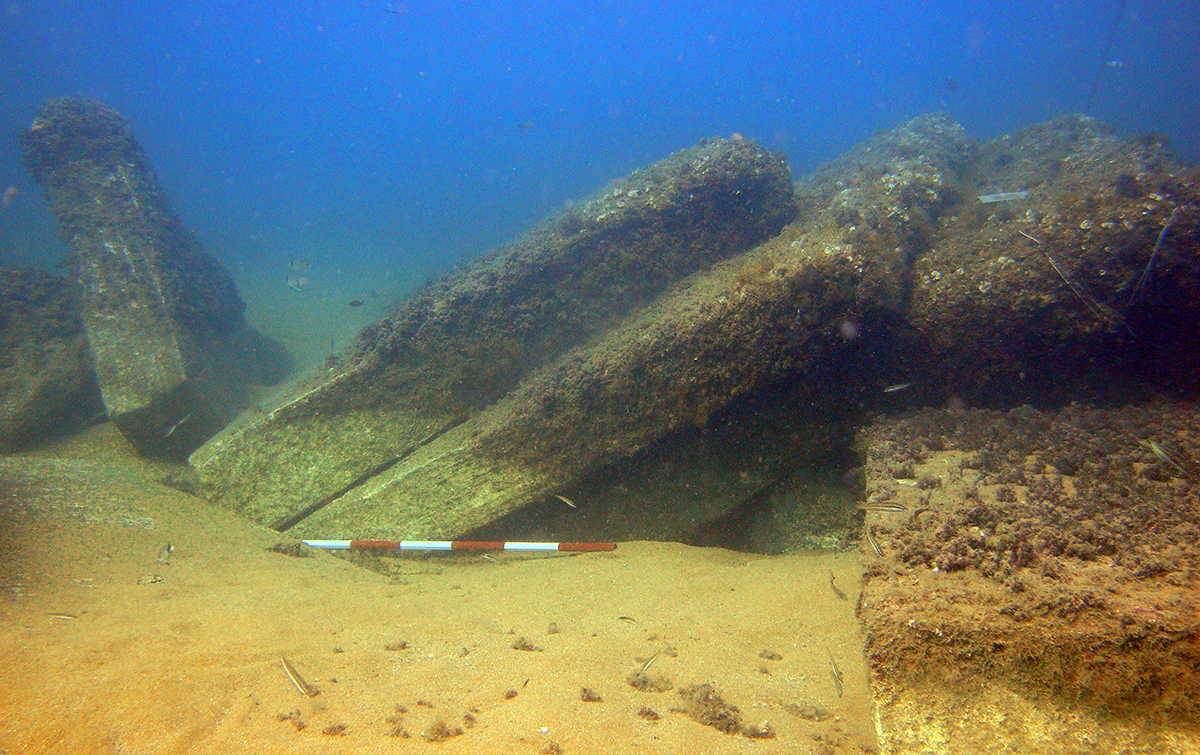
- Sources
- - Patrizio Pensabene - Porti marittimi a Porto e Ostia, fluviali a Roma e trasporto dei marmi per i cantieri dei fori imperiali
- - Aguilera Martín, A. (2012), ”La sirga en el Tiber en epoca romana”, in S. Keay (ed.), Rome, Portus and the Mediterranean, London 2012, 105-123.
- - Bruno, M. (1998), «Su un fusto colossale in cipollino sopra le cave di Kylindroi nel distretto di Myloi», in Pensabene P. (a cura di), Marmi antichi II. Cave e tecnica di lavorazione, provenienze e distribuzione, Roma, 327-332.
- - Daguet-Gagey, A. (1997), Les opera publica a Roma: 180-305 ap. J.-C., Paris 1997.
- - Gatti, G. (1936), «L’arginatura del Tevere a Marmorata (Un manoscritto inedito di P. Luigi M. Bruzza)», in BCom LXIV, 55-82.
- - Haselberger, L. (1994), “Ein Giebelriss der Vorhalle des Pantheon: Die Werkrisse vor dem Augustusmausoleum”, in RM 101, 279-308..
- - Heinzelmann M., Martin, A. (2002), «River port, navalia and harbour temple at Ostia: new results of a DAI-AAR Project», in JRA 15,1, 5-20.
- - Keay S. (2012), «The Port System of Imperial Rome», in Keay S. (ed.), Rome, Portus and the Mediterranean, London, 33-67.
- - Maischberger, M. (1997), Marmor in Rom. Anlieferung, Lager- und Werkplätze in der Kaiserzeit, (Palilia 1), Wiesbaden.
- - Marchetti, D. (1891), “Di un antico molo per lo sbarco dei marmi riconosciuto sulla riva sinistra del Tevere”, in BCom 19, 45-60.
- - Meiggs, R. (1997), Roman Ostia, Oxford (1ª ed. 1973).
- - Meneghini R. (1985), «Scavo di Lungotevere Testaccio», in Roma. Archeologia nel centro 2, 433-443.
- - Moccheggiani Carpano, C. (1984), «Il Tevere: archeologia e commercio», in Bollettino di Numismatica II, serie I, nn. 2-3, 21-80.
- - Moccheggiani Carpano, C. (1986), Archeologia subacquea: note di viaggio nell’Italia sommersa, Roma 1986.
- - Zevi, F., Cavalieri Manasse, G. (2005), «Il tempio cosiddetto di Augusto a Pozzuoli», in Sauron, G. e Lafon, X. (ed.), Théorie et pratique de l’architecture romaine. La norme et l’expérimentazion. Études offerts à Pierre Gros, Aix-en-Provence, 269-294.
Notes- 1:Pozzolana – Volcanic ash from Pozzuoli used for underwater concrete.
- 2: Patrizio Pensabene - Porti marittimi a Porto e Ostia, fluviali a Roma e trasporto dei marmi per i cantieri dei fori imperiali.
- 3: Photo - www.Grillo.nl
- 4:Harbour quarter in Rome between the Aventine Hill and the Rione Testaccio.
- 5:Drawing after da Maischberger 1970
- 6:Statio marmorum – office responsible for marble matters.
- 7:Naves caudicaria – classical Roman trade ship.
- 8:See also: ‘The hidden harbour’.
- 9:Now known as the Lateran Obelisk.
- 10: Photo: Gareth Harney
- 11: See also: ‘ Warehouse of the world’.
- 12: Monte Testaccio is an artificial mount of used and broken amphorae from antiquity.
- 13: Pietro Ercole Visconti (1802 – 1880) Italian archaeologist.
- 14: Meneghini 1985; Maischberger 1997, 61-93, 175-177; Keay 2012, 38
- 15: Gatti 1936, 55-82.
- 16: Pensabene 1994, 209-249.
- 17: Maischberger 1997.m
- 18: Haselberger 1994.
- 19: Marchetti 1891.
- 20: Rodolfo Amedeo Lanciani (1845 –1929) - Italian archaeologist.
- 21: Bruno 1998, 329.
- 22: Keay - 2012, p.24.
- 23: Meiggs 1973, 290.
- 24: Moccheggiani Carpano 1984, pp. 50,51.
- 25: Moccheggiani Carpano 1986, 560.
- 26: Maischberger 1997, p. 57.
- 27: A mix of opus reticulatum (small square tuff blocks) and at the angles and the sides of opus latericium (brick).
- 28: Ammiano Marcellino,17, 4, 14: cfr. Grenier 1990.
- 29: Maischberger 1997, 57.
- 30: CIL VI 8484, 8485.
- 31: Musei Vaticani, Gabinetto delle Carte Geografiche.
- 32: cfr. Meiggs 1973, 297.
- 33: Plin., NH, XXXVI, 4-8.
- 34: Cic., Ad Att. XIII, 6.
- 35: Heinzelmann, Martin 2002; Keay 2012, 41.
- 36: Illustration by Angelo Coccettini.
- 37: Zevi, Cavalieri Manasse 2005.
- 38: cfr. Daguet-Gagey 1997.
- 39: Aguilera Martín 2012, p.107.
- 40: Photo - https://onlinelibrary.wiley.com/






 We are committed to providing versions of our articles and interviews in several languages, but our first language is English.
We are committed to providing versions of our articles and interviews in several languages, but our first language is English.